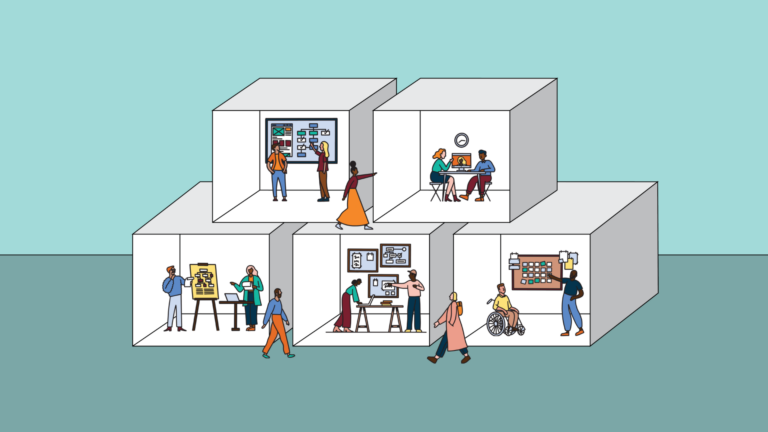Today, digital leaders at enterprise-level organizations are facing big challenges when it comes to their digital systems and tools. Expectations about the functionality, speed, and ease of using digital tools are high—and businesses are now defined by their digital experiences. Large organizations face the unique challenge of meeting these demands and improving their legacy applications while many customers and employees are currently using and relying on them.
This often leaves design and technology leaders wondering how to approach modernization work proactively and strategically to avoid mistakes, minimize gaps in existing services, and launch an application that meets modern standards. A modernization project can seem like an insurmountable lift—but a necessary one.
Understanding enterprise application modernization
Enterprise, or legacy application modernization, is the process of bringing outdated software and digital products up to modern standards—often including an audit and rethinking of design, technology, and internal processes. Modernizing applications is an extensive process that is intended to dramatically improve user experience, customer or employee satisfaction, and overall business impact. We’ve helped enterprise organization across various industries modernize their applications successfully.
5 essential lessons we learned from modernization projects
In our recent virtual event, Lessons Learned from Modernizing Enterprise Applications, we teamed up to share our experiences achieving successful modernization outcomes. We discussed the most important lessons we’ve learned from a design, technology, research, and content strategy perspective—and the advice we’d give anyone preparing to tackle a legacy application modernization initiative of their own. Here are the 5 key lessons we’ve learned.
1. There is value in modernizing vs. working with what you have
If you’re deciding whether to modernize a tool or service, there are several things your team should do to assess your current state and plan for the future. During this phase, consider the following benefits for your team and company.
You’ll gather up-to-date data
Before you can make decisions about updating a system or tool, you have to have information. Research is often the first step in a modernization effort—an important one. To kick things off, you should ask yourself these questions:
- How current is your existing data around customer needs and pain points?
- Do you have easy access to it, or does the knowledge live in someone’s head?
- Do you have a single source of truth for where to find the customer data you have?
If you don’t have clear answers to these questions, consider the benefits of a comprehensive research effort. Gathering updated customer data will help you understand where your modernization efforts should focus—and why.
You’ll understand existing content, gaps, and how to create content faster
When you perform a content inventory, you’ll discover how much content you have, what your competitors are providing that you aren’t, and whether your content meets customer needs. You’ll also be able to take stock of your information architecture and identify opportunities to move toward more structured content.
This kind of planning will help future-proof your content creation process and move you toward a “create once, publish everywhere” strategy. It will also dramatically reduce the time your team spends on managing content.
You’ll implement a design system to work more efficiently
Modernization work often involves implementing a design system. While this requires effort initially, it enables your design team to speed up the time it takes to concept, iterate, and test new features. It’s also an investment that often leads to more customer satisfaction, loyalty, and retention since your customers will see bugs getting fixed quickly and new features being added regularly.
From a business perspective, your company will become more efficient, gain a competitive edge in your market, and improve its brand reputation.
You’ll develop a more nimble technology architecture
A project only moves as fast as its slowest part. If you’re constantly troubleshooting CI/CD issues, you’re wasting time that you could spend releasing new features. Take stock of things like your software, deployment tools, and hosting platforms and consider how switching them could remove the impediments to faster deployment.
2. It’s essential to know how everyone in your organization feels about this initiative
Change can be challenging for teams and organizations, especially when it comes to a large lift project like legacy systems modernization. It’s critical to communicate with everyone involved in the effort and develop a thorough feedback plan. Ideally, everyone on your team should understand:
- Why this initiative is happening
- Who is driving the change
- What’s needed from them to support the work
- Which departments should be collaborating regularly
There are a few ways to do this.
Share the product vision with everyone involved and pay attention to how they react
As a leader in this effort and an advocate for modernization, you’ll want to understand the overall risk tolerance of your organization, the team’s UX maturity, and the company’s reaction to a design-driven business strategy. Then, share what you know with your design team.
Design leads can help educate your team when needed, remove existing silos, and contribute to the larger change management plan.
Remember that there are many digital assets involved in an app modernization effort, but also processes and people
Moving content through a complex workflow requires planning, creation, review, approval, and updates to a lot of content—and there are key people involved at every step. You need both processes and people on your side to launch a new product successfully.
Learn how content is managed today, who’s involved, what’s working, and what’s not. During those conversations, read the room. Learn not only how it’s done, but why—and talk to the team about how you can move towards a more ideal state.
Use research methods like workshops and surveys to gauge the temperature of your organization
You might be assuming that everyone is as excited about this initiative as you are, but making an effort to gather feedback can help you learn a lot about how people feel—both externally and internally. This step is essential to building a new digital product or tool that will perform well and be maintained in a welcome environment.
3. Decide what success looks like and how to measure it—together
During a large-scale modernization initiative, it’s essential for everyone to understand what they’re working toward—both individually and collectively. To remain clear about these goals, you can facilitate the following activities.
Learn what success means for everyone
Every discipline has its way of evaluating success, and so does the organization as a whole. Make sure there aren’t any major internal conflicts before you move forward.
Also, success will look very different for the business than it will for your customers. Make sure everyone is clear on what to aim for and measure.
Ready to modernize your legacy applications?
We can help with your legacy application modernization goals and get your team working faster, smarter, and better together.
Do a lot of the little things right to achieve big-picture success
For example, your technology team should be implementing solutions that are in line with what design is building, operating in a way that’s preventing technical debt, and addressing accessibility concerns regularly. Address tactical consistency in your sprint work to ensure you can reach your overall goals.
Keep reevaluating your goals as you make decisions
Look back at the research and make sure your team is implementing the content, designs, and features that address user needs. Process-wise, make sure you’re using time and resources efficiently—especially in enterprise environments. Your team should be looking for opportunities to reduce steps or time for the internal people involved in creating or updating content.
Remind yourself that success is based on outcomes, not features
Don’t get too caught up in the release of specific features—or on beating out the competition by introducing something new. You’ll want to stay focused on the outcomes of introducing a feature, including user feedback and internal success metrics. Gather user feedback, do design validation, and build the data you collect into future releases.
4. Understand what kind of debt your organization has, and how much
Debt in the form of time, resources, equipment/tools, personnel, knowledge, and more can be difficult to track if you’re not getting ahead of it—and it can compound over time. During the modernization process and beyond, there are a few ways your organization can create systems to help people identify and communicate about debt.
Prioritize strong leadership and formal processes across departments
Create an environment where people know and understand the channels for communicating about tangible UX and technical debt they can see by conducting audits and testing. Also, have formal processes in place to flag intangible communication debt that may be harder to see—ensuring there are proper roles, facilitators, and support to remove blockers and push the project forward.
Create open standards that anyone can access and follow
Public coding standards, for example, are essential for helping everyone on the team understand expectations when building code. This is one of the best ways to prevent the creation of tech debt. Ignoring accessibility standards can also be a significant source of debt, as remediation can be expensive for organizations from a legal perspective—and accessibility debt can significantly limit your ability to serve a wider audience.
Document what you know
In the course of building and maintaining modern tools, your team will develop implicit knowledge—things like, “This person in this department handles those requests,” or, “Our department tried that system before, and it didn’t work.” Make sure your team has a plan for storing and documenting implicit knowledge across departments so that you don’t create knowledge debt when people leave the company or when new people are hired.
Don’t allow a buildup of assets that no longer serve your customers
This comes up often from a content perspective, and regular audits and inventories can go a long way in preventing a buildup of excess content. It seems counterintuitive, but less is usually more when it comes to content. Make a plan to remove underperforming assets regularly.
5. Make sure handoffs are smooth and essential things don’t get lost
If you’re working with a third-party organization to help you through this application modernization there will come a point where work is handed off to your internal team to maintain and continue. Transparency is vital in this phase, and there are a few ways you can make this transition smoother.
Have regular, built-in touchpoints for everyone involved
Effective communication is hard, but it’s critical. Establish regular touchpoints for your cross-functional partners to help build rapport and respect within your internal teams and with external stakeholders.
Establish the right spaces to share and store information
Information repositories and communication tools like Confluence, Figma, Zoom, Storybook, and more are game-changers for teams. They make it easier to share and document the intent behind decisions and new initiatives. Build a shared language and help everyone understand the expected standards for deliverables.
Benefits of investing in app modernization
Through our experience with modernization work, we’ve witnessed numerous successful outcomes and benefits; we’re sharing a few below::
- Improved efficiency: We remove the complexities by rebuilding or replacing outdated, siloed systems and lean on automated tasks, design systems, and processes that make everyone’s jobs easier. This allows for better communication between systems (and teams), saves time, and helps you reach your business goals quicker.
- Scalability: Modern systems are built to be more scalable and iterative. Outdated systems cause issues with software versions, infrastructure, and siloed workflows. This flexibility allows businesses to iterate and release new features more regularly.
- Cost savings: Legacy systems can be expensive to maintain and update, becoming increasingly more costly as the system ages and issues arise. Streamlined processes can help reduce the need for regular manual maintenance and allow your team to focuse resources on improvements, not fixes.
- Improved user experience: Legacy systems can be challenging to navigate and use, and in our digital-first world, we’re used to modern interfaces and integrations that are easy to use (and nice to look at). By implementing modern interfaces, APIs, and intuitive workflows, you’ll provide your users with the experience they expect.
- Increased agility: We build modern systems with flexibility and adaptability in mind. When a problem or new need arises, you’ll lean on processes and systems in place (like a design system) to move new work forward—allowing you to quickly respond to changing market conditions and customer needs.
Legacy application modernization is a significant effort, but it pays off
The work in front of you may seem daunting, but the effort you put into avoiding common pitfalls will lead to much better outcomes for your company—and a much better working environment for your teams.
Gather the right data, communicate, plan ahead, and make sure you’re creating a “no surprises” environment throughout the process. Soon, you’ll be positioning your company as a digital leader in your industry, and you’ll be leading a team that’s working faster, smarter, and better together.
Do you need help planning and executing an enterprise modernization effort? Let’s talk it through and plan an approach that’s right for your team.



